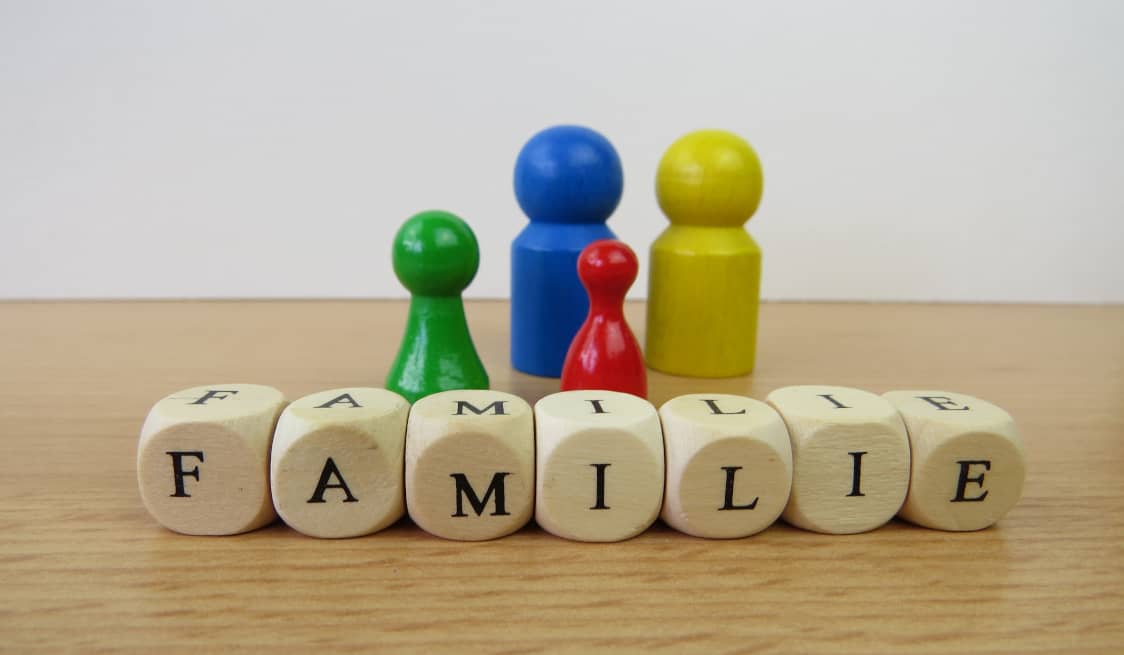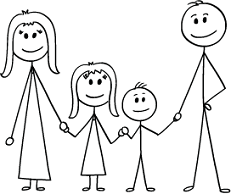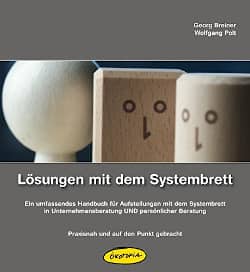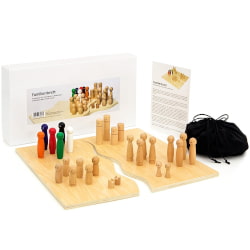Family Constellation
Definition - What is a Family Constellation?

Family constellation is a method from family therapy or systemic therapy in which individual people are positioned (constellated) in the room as representatives for family members and placed in relation to each other. The aim is to visualize the network of relationships within a family. Family constellations can take place in a group setting or with the help of figures and symbols on a family board.
The term "family constellation," "family placement," or "systemic family placement" can refer to different concepts and approaches. For example, there are constellations based on the approach of family therapist Virginia Satir, where the solution is open and constructively developed by the clients. There is also the method developed by Bert Hellinger, which has become very well known in recent decades, where a facilitator largely prescribes the solutions. There are also combinations and variations of these constellation forms. (See also Development of Family Constellation).
Table of Contents
- Definition
- What Happens?
- How Does a Family Constellation Work?
- Development
- How Long Does a Family Constellation Last?
- Procedure
- What Roles Are There?
- What Is the Hierarchy?
- What Is an Imaginative Family Constellation?
- What Is an Energetic Family Constellation?
- What Does It Really Bring?
- When Is It Useful?
- Can I Do It Myself?
- Who Is Allowed to Conduct It?
- What Dangers Are There?
- Criticism
- How to Learn?
- Further Reading
What Happens in a Family Constellation?
In the constellation, the members are initially arranged as the client's internal representation dictates. That is, a client positions the individual members of their family as they currently experience the relationships between the individuals and to themselves. They also appoint a representative for themselves and position them. Their inner, felt reality is thus made visible externally. The individuals who represent the positions of individual family members usually do not receive detailed information beforehand about whom they represent. They empathize with their position and describe from that perspective what they are currently perceiving. This can already lead to remarkable situations, for example, when the "aunt" being represented makes statements that actually correspond to those of the real aunt. The client observes the process initially from the outside and can later, towards the end of the constellation, reassume their own role in the family system.
How Does Family Constellation Work?
Our attitude toward life and our view of the world are largely shaped by our family. Here, we learn the first rules and norms. Some of these rules and beliefs have been in place for generations and can influence our feelings and actions. Much of this is unconscious to us. A family constellation provides a new perspective on our own family and on our feelings toward other members.
While the representatives of individual family members assume the position of another person, they do not engage in role-playing. They can freely perceive, from their assigned perspective, what is currently happening within them and express it. This may include statements about who among the other individuals is currently in the way, felt too close, or perceived as not belonging. Often, participants in their assigned position sense things that they cannot know in reality, such as someone missing or the relationship between father and daughter being somehow disrupted.
Thus, the constellation can help gain clarity about patterns within the family and the effects these patterns have on one's own life or the lives of their children. A view from the outside on painful experiences, taboo topics, or beliefs within the family can contribute to finding balance again or taking new steps in development.
Development of Family Constellation
The systemic family therapy and the beginnings of constellation work were established by Virginia Satir in the late 1960s in the USA. Satir aimed to make the relationships between family members visible through their body language. In a family sculpture, as she called it, the participating family members could represent themselves and sometimes even the symptom. In exaggerated body postures, they expressed their relationship to each other. The body posture was deliberately exaggerated to make the relationship patterns clear (e.g., extremely submissive or highly rational). The entire image was static, like a sculpture.
Afterwards, family members could share their feelings triggered by this image before another member expressed their view of the relationships. This served as the basis for further discussions and solution approaches. Another method developed by Satir was family reconstruction. In this form, clients acted out scenes from their family of origin, especially those that played a burdening role in their current lives. This allowed them to develop understanding for the parental generation and behaviors within their family, seeing some things in a different light.
Thea Schönfelder, a German psychiatrist, developed (inspired by Satir's work) a special form of family sculpture. She took clients' statements literally, e.g., "I'm attached to you," and had representatives realistically portray this. Additionally, clients could place other participants in relation to each other and first let this constellation affect them. Afterwards, they were asked about their feelings in this position. This approach, inquiring about the perceptions and feelings of the representatives, is now a common method in family constellation. Schönfelder also used for the first time the variant of placing representatives without further information about their role, gesture, or body posture. She is also considered, together with systemic therapist Kurt Ludewig, the inventor of the family board. On this board, a client can represent their family with wooden figures if no members or a group are available for a constellation.
Virginia Satir's concept was further developed in Germany by Matthias Varga von Kibéd and Insa Sparrer (Systemic Structural Constellation), and Thea Schönfelder's work significantly inspired their work.
Bert Hellinger first learned about family constellations from Thea Schönfelder. He made family constellations widely known in Germany, as he conducted live constellations on stage in large-scale events with thousands of spectators. Many people thus came into contact with family constellations for the first time and consider Hellinger the inventor of the method. Hellinger expanded constellation work through his "Orders of Love," where each member has a fixed place in a specific hierarchy, insights from a multi-generational perspective, the law of giving and taking within the family, or the pursuit of belonging. He selected representatives for the constellations who had no information about the family and positioned them. From questioning the representatives on stage, he deduced where the order was disrupted and positioned the representatives so that they were again in their correct place. For many critics, his methods and guidelines are considered too dogmatic and even dangerous because they excessively restrict the autonomy of the clients.

How Long Does a Family Constellation Take?
A constellation typically lasts 1 – 2 hours, sometimes a little longer. Preliminary discussions and possibly the creation of a genogram may also be required. Post-session discussions also require additional time. Constellations are often conducted as part of constellation evenings or entire weekends. This allows for enough people to be present to act as representatives. This time should also be factored in, even though one's own constellation only takes up a fraction of the time. However, for some profound issues, a single constellation may not be sufficient, and additional constellations may be necessary.
Family Constellation Process
Family constellations are often offered over the course of a weekend. The majority of present participants act as representatives, some of whom present their own concerns. Depending on the methodological focus and philosophical orientation of the facilitator, there are variations in the process of a family constellation.
- Preparation for Family Constellation
It is advisable to prepare for a constellation. The client should bring specific questions for which they seek answers or new solutions. Possible questions could include the impact of certain familial beliefs on their current financial situation or why they have such a strained relationship with their mother. These questions are important because the representatives are placed in relation to this topic. It is recommended to have a preliminary discussion with the coach/therapist conducting the family constellation. Another helpful preparation is creating a genogram of the family.
Preparing for a family constellation also involves selecting the facilitators carefully. Simply participating because the institute around the corner has a suitable schedule is usually not a good decision-making basis. - Process of Constellation - Summary
Who belongs to the family? Who is involved in the relevant problem? After the key members are identified, a representative is chosen for each and intuitively positioned in the room by the client. A representative is also appointed for the client themselves. The positions of individuals in the constellation are determined based on the client's subjective inner image. Subsequently, the representatives are questioned about their perceptions and feelings, often yielding initial insights.
Next, the facilitating therapist or coach alters individual positions and observes the effects. The client initially observes the scene and the changes from the outside and returns to their position in the family system shortly before the end of the constellations. In some constellations, the representatives may leave their positions or be led by the client to other positions until everyone is satisfied and a solution emerges.
In some constellations, formulating and expressing healing sentences is part of the process. These may express love or the relationship with other members, such as "Dear Mom, I am your son, and you are my mother," or "Dear X, you are my brother and have passed away, but you remain my brother, and I love you." Some sentences are provided by facilitators, while others are formulated individually by the client. Finally, all representatives are released from their roles and bid farewell by their own name.
Roles in a Family Constellation

Depending on the issue, family members related to the specific question are placed in the constellation. However, it may be that additional members join later. Usually, father, mother, children, siblings, etc., are placed, sometimes even grandparents. For example, one person may be in the role of the daughter (toward her father and mother) and simultaneously in the mother role toward her own daughter or son.
What is the Hierarchy in a Family Constellation?
The term was coined by Hellinger and is based on his concept of "Orders of Love." According to this, everyone in the family has a very specific place that belongs only to them. This is defined by a certain hierarchical order that must be observed by the family members. If this hierarchy is disrupted, individual family members may become ill. The hierarchy is determined by the time of belonging to the family. It states that those who belong to the family first rank above the family members who joined later.
Therefore, parents come before children in the hierarchy, and first-borns come before their siblings born later. Whoever was there first comes first in the hierarchy. This also applies if the first-born has already passed away. Some stand higher and therefore come first, some stand lower (i.e., beneath them) and therefore come afterward. The order is disrupted when a subordinate member rises above a member who ranks higher in the hierarchy. This means, for example, that a child "presumes" to rise above its parents out of love by taking on something that is the parents' responsibility. Beliefs here include, for example, "I would rather get sick than you."
Not only who, but also what comes first in a system takes precedence over what comes afterward. Thus, the couple relationship takes precedence over parenthood. Within family systems, there is also a hierarchy, but the chronological order is reversed here: the new system (e.g., the present family) takes precedence over the old system (the family of origin). In a constellation, the injured orders are to be restored.
What is an Imaginative Family Constellation?
Not always are there enough people present to act as representatives for a constellation. Sometimes, there is also a need in coaching or psychotherapy to address emerging issues immediately without the presence of mother, father, son, or daughter. Robert Dilts, one of the co-founders of NLP, developed a method called Re-Imprinting in the late 1980s to conduct an imaginative family constellation even without representatives. For this purpose, so-called floor anchors (objects or simply pieces of paper) are laid out on the floor and symbolically represent the other family members. This also expresses how the client internally experiences their family and their relationships.
Instead of a representative, the client themselves sequentially takes on the different positions and senses what the embodied person needs in that moment. From a meta-perspective, an observer position from the outside, they can formulate the necessary resources and solution thoughts themselves and mentally convey them to the respective person.
What is an Energetic Family Constellation?
In energetic family constellations, it is assumed that the concern is already present in the "knowing field" and can be sensed. It follows no fixed order, sometimes does not even require representatives, but is based on the energy present in relationships and in the morphogenetic field. Often, "energetic constellation" is simply another term for constellation work that does not follow a clear process.
Family Constellation - What Does It Really Bring?
A constellation can bring clarity to the relationship patterns of a family, new insights into mechanisms and established patterns that we have unconsciously and unreflectively adopted in our family. Often, this is the first step towards new, constructive relationships within the family and in one's own life. However, those who enter a constellation without a specific question cannot expect concrete answers. Therefore, a clear formulation of the concern in advance is important. Frequently, the question arises as to when a family constellation takes effect. Depending on the theme being addressed, solution strategies can emerge very quickly, immediately after the constellation, or within the next few days; some developments may only manifest over several weeks. It can indeed take some time for a constellation to take effect.
The aftermath may also include changes in areas of life that were not initially the focus and that were not initially associated with the constellation. For example, solving a work-related problem after addressing the unclear relationship between mother and son. However, it may also be the case that a constellation does not bring a clear insight. The question of what happens afterward is handled differently by different constellation facilitators. Some recommend letting the constellation and the "solution image" work first and not discussing it. If the solution image is constructive and the client leaves the constellation with a feeling of relief or insight, this is entirely legitimate. In cases of unclear conclusions, the possibility should exist to further process the experience with the facilitator or coach.
When Is a Family Constellation Useful?
A family constellation is not a panacea and is not indicated for every issue. Furthermore, a constellation should not be equated with therapy. However, it can make sense if problems are likely to be related to the family or have a suspected familial background. Therefore, anyone who wants to do a family constellation should have a specific question. Examples of questions or reasons for a constellation include:
- Unexplained, recurring burdens, crises, separation, or failure of life plans
- Suspected blockages due to beliefs that apply in the family system (Never incur debts! Separation is a sin! etc.)
- Strong feelings of guilt, obligations, or remorse that cannot be explained.
- A suspected or actually experienced trauma within the family (if the constellation is part of psychotherapy)
- Ruptures, conflicts, avoidance of contact with family members (or other close individuals)
- The suspicion that certain diseases may be related to the family
- Unfulfilled desire for children
- Unexplainable feeling of loss of a person, with the suspicion of having a lost twin
- Self-esteem issues, if rooted in early childhood.
- Etc.
Can I Do a Family Constellation Myself? In the Context of Self-Coaching?
It is generally not recommended. If you suspect that problems are related to familial backgrounds, you can engage with the family structure by creating a genogram. As with most forms of self-coaching, i.e., without accompanying coaching, it is often difficult to ask the right questions or follow up in the right places during a constellation. Furthermore, experiences or insights may arise that cannot be handled independently and therefore should ideally be accompanied by an experienced facilitator.
Who Is Allowed to Facilitate a Family Constellation?
A constellation can have profound effects on the client's psyche. So who is allowed to facilitate a constellation? The procedure is not protected. Thus, in principle, anyone who feels called to do so can offer constellations. Some constellation facilitators have attended a multi-day course and have little other training in psychology, coaching, or therapy. Others are well-trained through multi-month, job-accompanying training with regular supervision and are also usually systemic coaches or therapists, psychologists, or social workers.
During a constellation, dynamics can arise that an inexperienced or inadequately trained facilitator cannot handle. It is secondary which method the facilitator uses to conduct the constellation, whether according to a specific concept or more freely, following their inner intuition. Therefore, anyone wishing to have a constellation conducted should pay close attention to whom they entrust it to. Often, participating as a representative in a constellation is a good opportunity to get to know the facilitator and their approach to clients. Caution is advised with overly grand promises of healing.
What Are the Risks of Family Constellations?
A constellation can delve deeply and bring long-buried emotions to the surface. It can be very emotional and stirring, not only for the clients but also for the representatives. Those who have constellations often find themselves in difficulties and are under great stress. From this situation, a family constellation sometimes appears to be the last resort, and expectations of it are extremely high. However, engaging in this form of dealing with one's own family, often associated with pain, suffering, grief, or anger, is not advisable in situations of very high stress. A constellation can be additionally burdensome, especially when dealing with very painful issues.
Choosing the wrong constellation facilitator can also be dangerous. There are many well-trained and empathetic facilitators who accompany their clients well and are available for discussions after the constellation. However, there are also facilitators who do not have the necessary personal and professional competence and leave their participating clients alone. In this case, a constellation and the associated experiences can become dangerous. Sometimes, statements made by representatives or the image of the family are not seen as a momentary assessment or expression of inner experience but as immutable truth. Without follow-up work, this can lead to disastrous consequences.
Also, dogmatic or insensitive interpretations by the facilitator, who is seen as an authority in that case, can cause additional distress to the client. Also, with certain disorders, psychoses, severe depressions, borderline personality disorder, epilepsy, or experienced traumas, constellations are not suitable or can become dangerous. In these cases, a different approach within family therapy is more appropriate.
Criticism of Family Constellations
The mentioned risks, if disregarded, are a major point of criticism of family constellations. Furthermore, constellations have come under criticism when people with serious concerns are spectacularly presented on stage in mass events. Also, the dogmatic approach of Hellinger and some of his followers has led to strong resistance and skepticism towards the method. In the market of constellations, there are also many self-proclaimed facilitators who have hardly any adequate training.
How to Learn Family Constellations?
There are many courses on constellation work or systemic family constellations, ranging from a few days to job-accompanying further education with supervision as part of family therapy or systemic training. A constellation is not therapy but is sometimes advertised with promises of healing. It is important to emphasize that therapy may only be conducted by individuals who are medical doctors or psychotherapists or who have permission to practice medicine under the Heilpraktiker law.







